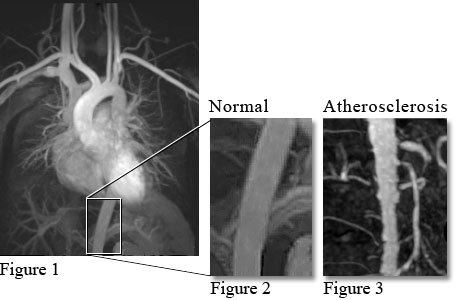What is atherosclerosis of the aorta?
Having atherosclerosis (say "ath-uh-roh-skluh-ROH-sis") of the aorta means that a material called plaque (fat and calcium) has built up in the inside wall of a large blood vessel called the aorta. This plaque buildup is sometimes called "hardening of the arteries."
The aorta is the main artery that sends oxygen-rich blood from the heart out to the body and to the brain. It runs from your heart down through your stomach area.
When plaque builds up in the aorta, it can weaken, stretch, or tear it. This can lead to problems such as a stroke, an aortic aneurysm, an aortic dissection, and reduced blood flow to the legs.
What are the symptoms of atherosclerosis of the aorta?
Atherosclerosis doesn't cause symptoms on its own. You may not have any symptoms unless the plaque buildup causes other problems such as a stroke, an aortic aneurysm, an aortic dissection, or blocked blood flow in the leg.
Magnetic resonance angiogram (MRA) of blood vessels

Courtesy of Intermountain Medical Imaging, Boise, Idaho.
Figure 1 and Figure 2 show MRAs of the normal smooth appearance of the large blood vessel (aorta) that carries blood from the heart.
Figure 3 shows an MRA of a narrowed and abnormal aorta from the buildup of calcium and fat (cholesterol) in the inner lining of the artery, often called "hardening of the arteries" (atherosclerosis).
How is atherosclerosis of the aorta treated?
Atherosclerosis of the aorta can be treated with a heart-healthy lifestyle and medicines that help lower your risk of serious problems. These medicines include:
- High blood pressure medicines such as ACE (angiotensin-converting enzyme) inhibitors, ARBs (angiotensin II receptor blockers), and beta-blockers.
- Cholesterol medicines, such as statins and other medicines to lower cholesterol.
- Medicine that prevents blood clots, such as aspirin. These medicines prevent blood clots that can cause a heart attack or stroke.
How can you care for yourself when you have atherosclerosis of the aorta?
Heart-healthy lifestyle
- Do not smoke. If you need help quitting, talk to your doctor about stop-smoking programs and medicines. These can increase your chances of quitting for good.
- Eat heart-healthy foods such as vegetables, fruits, nuts, beans, lean meat, fish, and whole grains. Limit sodium, sugars, and alcohol.
- If your doctor recommends it, get more exercise. Walking is a good choice. Bit by bit, increase the amount you walk every day. Try for at least 30 minutes on most days of the week.
- Stay at a weight that's healthy for you. Talk to your doctor if you need help losing weight.
Medicines
- Be safe with medicines. Take your medicines exactly as prescribed. Call your doctor if you think you are having a problem with your medicine.
- If you take a blood thinner, be sure to get instructions about how to take your medicine safely. Blood thinners can cause serious bleeding problems.
- Do not take any vitamins, over-the-counter drugs, or herbal products without talking to your doctor first.
Staying healthy
- Avoid infections such as COVID-19, colds, and the flu. Get a pneumococcal vaccine. If you have had one before, ask your doctor if you need another dose. Get the flu vaccine every year. Stay up to date on your COVID-19 vaccines.
- Manage other health problems, such as diabetes.
- If you have high blood pressure, it's very important to monitor your blood pressure and take your blood pressure medicines.
- If you think you may have a problem with alcohol or drug use, talk to your doctor.
Atherosclerosis of the aorta: When to call
Call 911 anytime you think you may need emergency care. For example, call if:
- You passed out (lost consciousness).
- You have severe pain in your belly, back, or chest.
- You have severe trouble breathing.
- You have sudden symptoms in your leg or foot such as severe pain, numbness, weakness, tingling, cool skin, or skin color changes. Your skin may be pale, bluish, or purplish.
- You cough up blood.
- You have symptoms of a heart attack. These may include:
- Chest pain or pressure, or a strange feeling in the chest.
- Sweating.
- Shortness of breath.
- Nausea or vomiting.
- Pain, pressure, or a strange feeling in the back, neck, jaw, or upper belly or in one or both shoulders or arms.
- Lightheadedness or sudden weakness.
- A fast or irregular heartbeat.
- You have symptoms of a stroke. These may include:
- Sudden numbness, tingling, weakness, or loss of movement in your face, arm, or leg, especially on only one side of your body.
- Sudden vision changes.
- Sudden trouble speaking.
- Sudden confusion or trouble understanding simple statements.
- Sudden problems with walking or balance.
- A sudden, severe headache that is different from past headaches.
Watch closely for changes in your health, and be sure to contact your doctor if you have any problems.
©2011-2025 Healthwise, Incorporated
